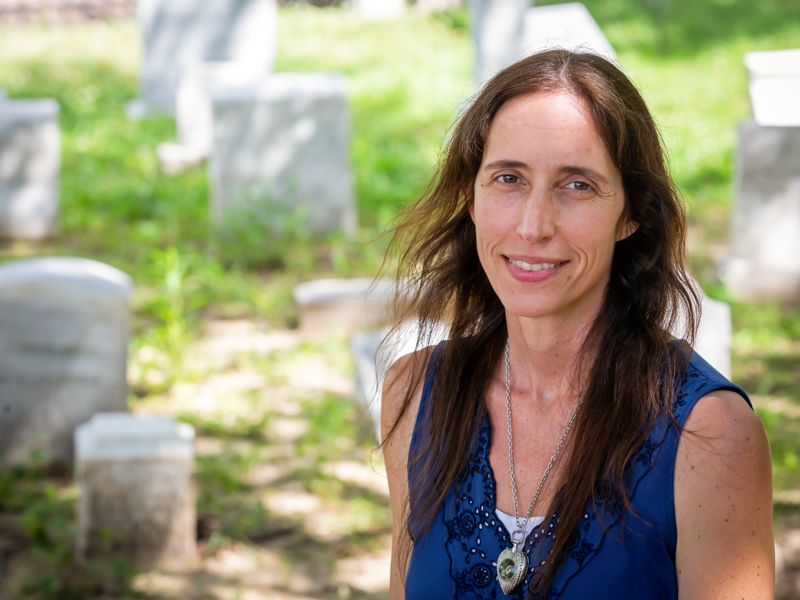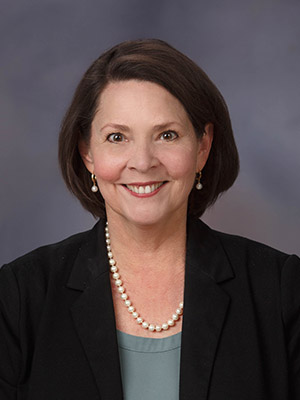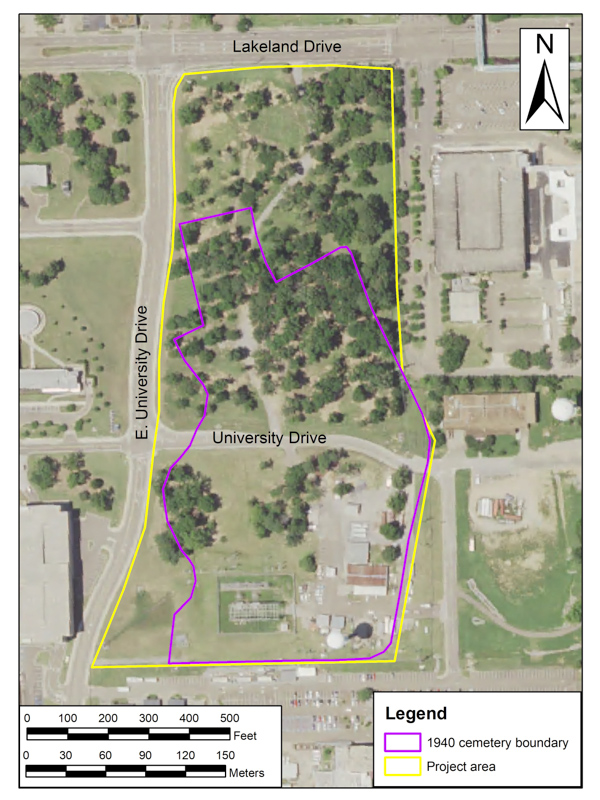Their markers didn’t last, but their stories will, says new Asylum Hill scholar

News of the graves discovered several feet beneath a campus road raced more than 700 miles from Jackson to Iowa City, running smack into the aspirations of Dr. Jennifer Mack.
“I thought, ‘That thing in Mississippi – that’s going to be my next big project,’” Mack said.
Now, 10 years later, it is.
In early April, Mack moved into an office at the University of Mississippi Medical Center to help breathe life into the stories of people long dead and almost forgotten and ensure that UMMC has land for future use.
As lead bioarchaeologist for the Asylum Hill Project, she has joined the effort to exhume, study and memorialize the people buried in thousands more graves uncovered since that first discovery in 2012 on Medical Center land.
“This project is larger than any I’ve worked on before,” she said.
That’s coming from someone who has been part of archaeological excavations in this country, Ireland, Germany, Serbia, Kazakhstan and Uzbekistan.
While working for University of Iowa, Mack scrutinized human remains from a Stone Age tomb discovered in Portugal.
Just 85 miles from Iowa City, she helped excavate a large Catholic graveyard named the Third Street Cemetery, a feat that led her to describe it as co-author of “Dubuque's Forgotten Cemetery: Excavating a Nineteenth-century Burial Ground in a Twenty-first-century City.” For that, the Society for Historical Archaeology presented her and colleague Robin Lillie with the 2017 James Deetz book award.

“I believe she is the perfect person to work on Asylum Hill,” said Lida Gibson, assessments and research coordinator for the project and a film documentarian coordinating its oral history mission.
That mission began soon after a road construction crew unearthed a decade ago the resting place for about five dozen unmarked, pine coffins. The workers had accidentally bared burial ground remains from the long-shuttered Mississippi State Insane Hospital, originally the Mississippi State Lunatic Asylum, from which the project takes its name.
Since then, UMMC officials have sought an ethical way to reclaim the burial site for potential land development. That means navigating a path that serves patients in the Medical Center’s future, who deserve the services of a campus allowed to improve and expand; and patients from the past, former asylum residents, who merit respect.
“We need someone with Jennifer Mack’s experience excavating human remains at historic cemeteries,” Gibson said. “Someone who knows the protocols and the respectful nature that goes into exhuming these individuals.”
As for returning those individuals who can be positively identified to families for reburial, project leaders are working with known descendants to resolve legal and practical issues, Gibson said. Otherwise, a planned memorial/lab will serve as a “permanent resting place.”
As a bioarchaeology project, “it is one of the largest, if not the largest, ever undertaken in the United States,” said Dr. George Bey III, a member of the Asylum Hill Research Consortium serving as education coordinator, helping develop a multi-year field school program for budding archaeologists.

“Dr. Mack has directed large-scale burial excavations and knows how to get the remains out of the ground, properly curated and treated,” said Bey, professor of anthropology and Chisholm Foundation Chair in Arts and Sciences at Millsaps College in Jackson.
“She also has worked with communities to make sure the human remains were treated ethically and the descendant communities are respected. She brought the experience and expertise we needed.”
Mack had been waiting for an opportunity to come back South, where she had explored cemeteries as a young girl in her Florida hometown.
“In Pensacola, the Victorian cemeteries above ground were like art displays, so beautiful,” Mack said. “It was fascinating to me that you could put together stories about a person’s life by reading the words on these monuments.”
When she was 10, her mom arranged for her to go on a real archaeological dig for a day. “It was miserably hot,” Mack said. “I got blisters and we didn’t find anything.” This put her out of sorts with archaeology. The estrangement did not last.
During her second year of college, an art history course at Emory University put her heart a-flutter again. An internship at Historic Oakland Cemetery in Atlanta sustained the beat.
On her journey to a career in archaeology, Mack strayed from the usual course. “I started in general archaeology and forced my way in, working primarily in cultural resource management,” she said. Distinguished from academic archaeology, it embraces threatened or vulnerable historical sites, protecting and managing elements of its heritage.
“As an archaeologist, though, you end up working in unmarked cemeteries,” she said. “Those are the ones that tend to have construction encroach on them when people don’t realize they are there.”
In Dubuque, construction had, several times, disturbed the unmarked 19th century burial ground dedicated to the Catholic parishioners of St. Raphael’s Cathedral. Eventually, the Iowa Office of the State Archaeologist moved more than 900 of the burials that remained. For five years, starting in 2008, Mack was involved in the excavation.
“Thirteen people were presumptively identified,” she said. There were some clues. “They were buried in family groups,” Mack said. “Also, there were some partially preserved coffin lid crosses.
“Coffin lid crosses were common decorations in Catholic burials through the late 19th century. And these crosses were often engraved with the name of the deceased, date of death and age at death.”
But markings, decorative or otherwise, are absent for the asylum patients. “They weren’t buried in unmarked graves,” Mack said. “They were buried with wooden markers, but wooden markers don’t last.”
Those had marked, for a time, the graves of those who had not been claimed by families from an institution that operated between 1855 and 1935 on what became Medical Center property. Thousands of asylum patients died. Through modern-day geophysical surveys and other means, as many as 7,000 are estimated to lie under several acres.
Telling their stories is easier than connecting remains with names.
Mack, who earned her PhD in archaeology at England’s University of Exeter, is also schooled in human osteology. Through analysis of skeletal remains, she can yield an “osteobiography”: age, sex, ancestry, height, evidence of illness, evidence of trauma and activity.
“Once we have that information, as well as burial date information that can be gleaned from the materials in the graves, such as coffin nails, all of that can be compared to burial records,” Mack said.
“In some cases, we can narrow down pretty well the candidate pool for the identity of the person buried in an individual grave.” A DNA comparison might be possible if descendants are still around, she said.
“Even if the osteobiography doesn’t narrow down the possibilities to a person with a certain name, we can still tell a story about a life – particularly with the help of descendants.
“For me, that’s really the goal: to return the personhood to the individual, and remove from them this imposed anonymity.”
ASYLUM HILL PROJECT – NEXT STEPS
- Preliminary mapping of the asylum cemetery site is set to start this month.
- Jennifer Mack is working with the UMMC Office of Facilities Services to plan exhumations, which are scheduled to start this fall in an area occupying the northeast corner of campus bounded by Lakeland Drive on the north (see aerial map).
- Descendants of the patients have been invited to participate in virtual question-and-answer sessions about the excavations, as well as oral histories on video. The first session is 10:30 a.m. to 4 p.m. July 23 at the Gulfport Public Library Community Room, 1708 25th, Gulfport, with presentations by Dr. Jennifer Mack and Dr. Amy Forbes, professor of history, Millsaps College. For more information, the contact is Lida Gibson, lbgibson@umc.edu, or 601-984-6790.


